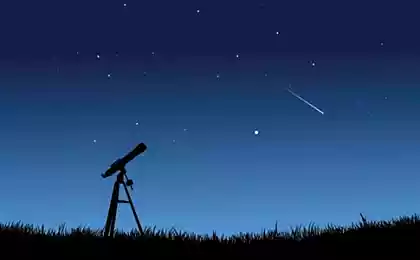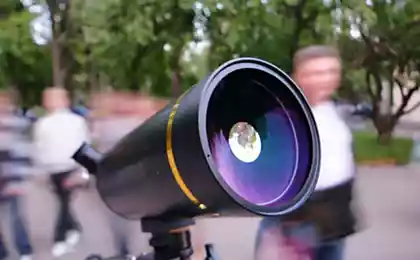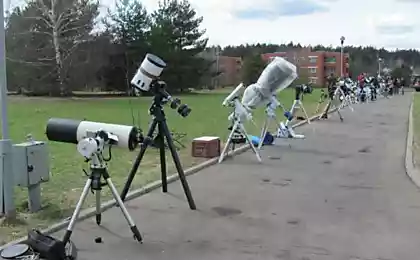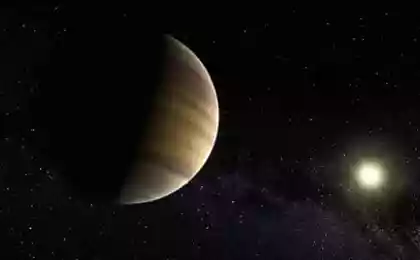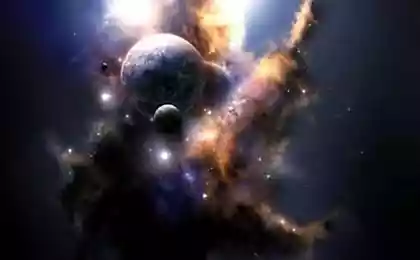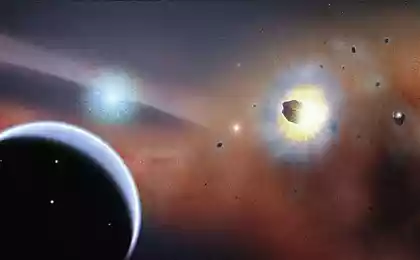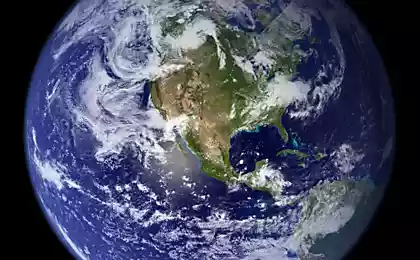1460
ADI method for direct observation of exoplanets - how it works
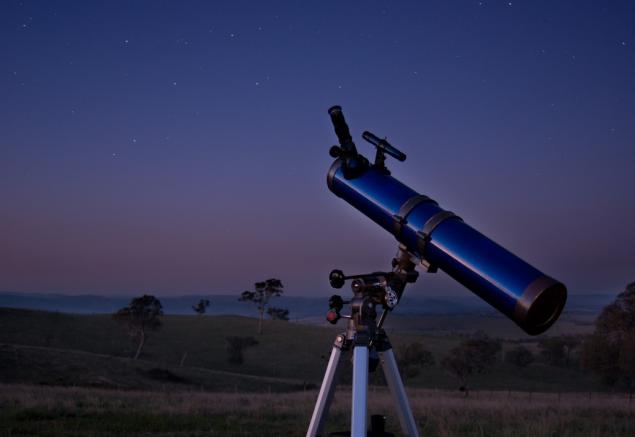
[From the interpreter] Probably a lot when it comes to finding exoplanets imagine a person looking into the eyepiece of a huge telescope. Unfortunately it does not work. Even for the best of modern telescopes observe exoplanets - a difficult task, as the planets themselves are of small size, and their radiation is extremely difficult to distinguish from the stellar radiation. To do this, use a number of interesting methods, one of which - ADI (Angular Differential Imaging) - and will be discussed in this article. I>
Introduction
One of the most difficult challenges facing modern astronomy - shoot planets outside the solar system and orbiting other stars. On the complexity of this task can be compared to finding a firefly that flies around a 300-watt spotlight on a few kilometers away from the observer - in order to distinguish the sources of radiation are close to each other, you will need not only a mirror of large diameter, but also the most advanced optics that can compensate for the distortions caused by the Earth's atmosphere. However, even if you will have access to the most advanced optical telescopes, the image that you will get will look something like this:
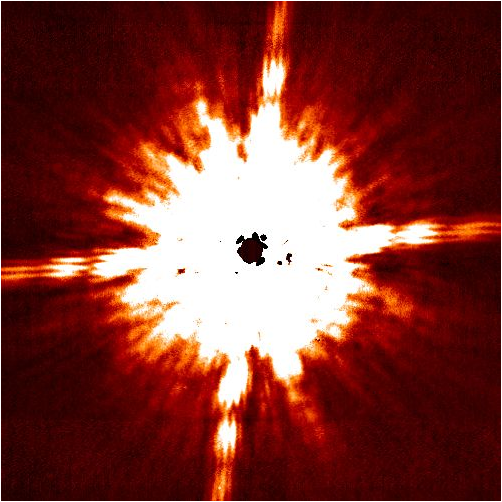
Here is the raw image of the star GJ 758. It is made at a wavelength of 1, 6mkm, so the colors are false - color change from black to red only shows the change in brightness. Black spots in the center - this area is so bright that accurately measure their value at current settings of equipment failed. Finally, the white rays - a diffraction distortion introduced in the present case because of the telescope so-called stretch marks - structural elements that hold the secondary mirror of the telescope.
Around GJ 758 rotate the two candidates for the title of exoplanets, but to distinguish them in this image is not possible, since a huge halo completely "clog" their light. For the detection of these objects must be as good as possible "clean" image of the light of the star - but how to distinguish star light from the light of the planet and the diffraction distortion? To do this, we must first understand why the distortions appear at all.
Distortions
The most obvious source of distortion, forming a halo around the star, it's the atmosphere of the Earth. Star light passing therethrough is distorted before they arrive at the telescope mirror. Moreover, since the atmosphere is always in motion, these distortions are not constant but variable, and change them very quickly - every few tens of milliseconds. It is this atmosphere scattered starlight and will look like a soft halo around the star. Modern optics to some degree reduce the amount of distortion, but does not eliminate them completely in order.
Another b on i> lshim source distortions are flaws in the mirrors of the telescope, as well as stretching, in which the secondary mirror is mounted. These distortions will have a much more permanent - they will vary, for example, due to fluctuations in temperature, or due to movement of some parts of the telescope relative to the other. Because of this constancy of such distortions is called pseudo-static. It pseudostatic distortions are responsible for the appearance of dark spots on the halo, which, although similar to the planet, but in reality they are not.
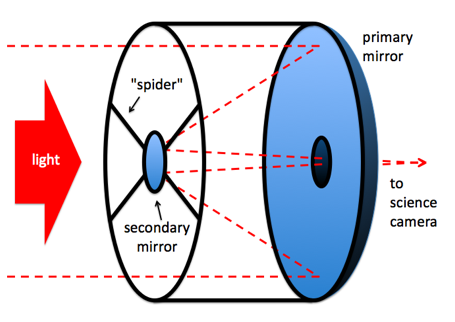
Scheme of the mutual arrangement of the primary and secondary mirrors of a large telescope.
Rotating field
Having dealt with distortions, proceed to the particular observations, which made it possible to use the method of ADI.
Let's look at the night sky. Instead of boundless space, the observer on Earth could well imagine a huge sphere that surrounds our planet, and which projected stars. From the point of view of the observer, the celestial sphere will rotate slowly, making one complete revolution in 24 hours. This is caused by the Earth's rotation around its axis, and makes the process of observation, as the star rotates together with the celestial sphere, will strives to "escape" from a field of view of the telescope. To compensate for this, telescopes mounted on a special rotating platforms that allow to configure how the inclination angle (measured from the horizon), and turn the telescope to the desired azimuth. After targeting telescope begins to rotate continuously at low speed to a visible image seemed motionless. It is worth noting also that during the rotation of the celestial sphere relative position of the stars relative to each other and the sphere itself remains unchanged. This whole process is shown in the following image:
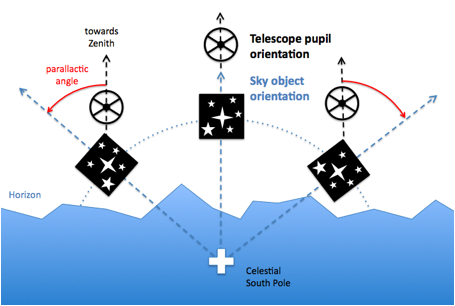
Here, the black squares with the Stars is the field of view of the telescope - the part of the sky, which we observe. As you can see, the field is constantly rotating, but the relative position of the stars relative to each other and relative to the pole of the celestial sphere remains unchanged. If we want to constantly get a still picture, we have to rotate the telescope at an angle, as shown by red arrows. The angle between the target, the zenith, and the pole of the celestial sphere is called the parallax angle. During the night, he is constantly changing, but the rate of this change is not constant - it will be the greatest when our target will be at the zenith.
Technology ADI
Using the fact that the field of the telescope rotates relative thereto for observation ADI method to distinguish cause distortion of the halo from the real sources of light.
As we have already explained, at the usual observation field of view, due to the rotation of the telescope, keep a constant angle to the observer. This allows you to take a few pictures during the whole observation period and apply them to each other. But when using the ADI, the telescope is not rotating. In this case, the true light sources continue to rotate together with the celestial sphere, but sources pseudostatical distortions (eg, streamers) cease to move.
The following figure shows how to process a series of images obtained by ADI-method (indicated as A i sub>). First, you must calculate the per-pixel average among all the received images (B). On average, this will be clearly visible structures that did not change during the observation period (the same pseudostatic distortion, as well as the star itself), but the planet is practically manifested. Then, the obtained average is subtracted from each of the original image (C i sup> = A i sup> - B), whereby there will be only small planet and random noises. Thereafter, each of the images will be rotated to match the actual coordinates of the celestial sphere (ie, as they would look with Derotator). Finally, rotate the image of the D will again calculate the average E. It all smooth out random noise, but all the images of the planet will overlap, making them more precise.
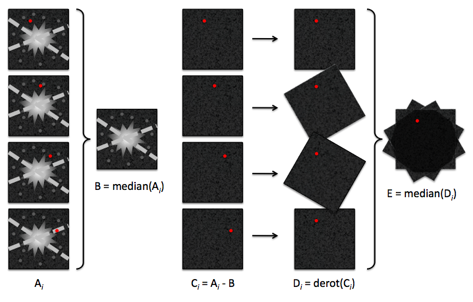
The following image you can see the result of applying this method to the star with the first picture in this article. Despite the fact that completely remove the halo could not (it was not completely static), ADI has allowed us to distinguish two objects close enough to the star:
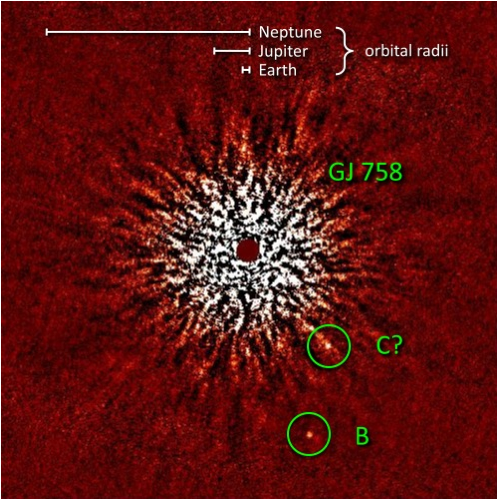
To B in this image has been identified as a planet, and the status of the object C is not defined yet. White stripes on top are shown for size comparison of the orbits of objects with sizes of the orbits of some planets of the solar system.
It is worth noting that the observations for ADI should be done when the target is at the zenith, that is, when the rotation of the field is with the greatest speed.
LOCI
So, we considered the easiest way to obtain and process the images - ADI. A more sophisticated method called LOCI (Locally Optimized Combination of Images - locally optimized combination of images) uses a fairly intricate algorithm that instead of simply subtracting the average to better define the background on each of the images of the series. For this image are divided into ring segments, then each segment optimized independently. This allows you to better eliminate noise in images taken with a short time, and increases the contrast of the resulting image. In particular, the picture above was obtained exactly using LOCI.
KDPV - Telescope by Ryan Wick, CC-BY
Source: habrahabr.ru/post/205480/
Automatic radio-electronic secretary, or ARS, or Arsik (1966)
As we depart from the Earth: a brief guide for going into orbit

